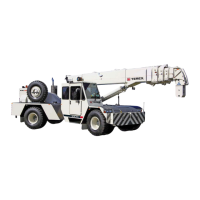DEFINITIONS
Articulation – The crane pivots in the middle to allow steering and slewing of the
load. Working Areas for the purpose of determining Rated Capacity are less than
10 Articulation, and greater than 10 Articulation, in either direction, from straight
ahead. Up to 40 Articulation is possible in either direction. See Working Area
diagram
Deration – A decrease in the Rated Capacity due to external influences,
expressed as a percentage.
Freely Suspended Load – Load hanging free with no direct external force applied
except by the winch rope.
Load Radius – Horizontal distance from the centre of the front wheels forwards to
the centre of the winch rope or tackle with load applied. “Radius” on Rated
Capacity charts refers to the Load Radius in metres.
Loaded Boom Angle – This is given to assist in setting up the crane only. It gives
only an approximation of the Load Radius for a specified boom length. No
allowance is made for boom or tyre deflection. “Boom Angle” on Rated Capacity
charts refers to the Loaded Boom Angle in degrees.
Load Moment Indicator (LMI) - A system which indicates, visually and audibly, to
the operator when the Rated Capacity is approached and reached.
Rated Capacity (RC) – The total Freely Suspended Load, including the mass of
material and load handling equipment, that the machine can safely lift under ideal
conditions at a given boom length and Load Radius.
Side Load – Any external force applied either to the boom or load in a horizontal
direction.
Work Areas – Area measured in an arc about the centre pivot as shown on the
Working Area diagram. The “Articulation (green/amber)” icon on the LMI indicates
which zone the crane is in. Green indicates less than 10 Articulation. Amber
indicates greater than 10 Articulation.
4 MXC1347B

